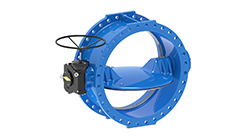.jpg)
The function of a wafer butterfly valve is to retain a seal for protecting it against dual-directional pressure differential in the flow of fluid. In simpler words, the wafer version of butterfly valves designed for keeping a tight seal to safeguard against the bi-directional pressure differential for avoiding any backflow in systems that have been manufactured for uni-directional flow. This is obtained by using a tightly fitted seal like an O-ring, precision machines, gasket, and a flat valve face on the downstream and upstream sections of the valve. Both of the wafer and lug butterfly valves have been used in a wide number of applications for industrial sectors which involve pharmaceutical, food processing, oil, chemical, water along with waster water management. The valves which are used in these industries are manufactured mainly in compliance with cGMP (current good manufacturing practice) and "Pharmaceutical Quality/Manufacturing Standard" guidelines. Butterfly Valves for most of the cases have replaced ball valves for a wide number of industries, this is mainly the case for those who are dealing with petroleum as they are much less expensive and are easy to install. Wafer butterfly valves are assembled using nuts and rods. They are installed above the ground for reducing the congestion. These valves are suitable for low-pressure systems and all kinds of fluids.
Specifications
|
Construction |
Concentric butterfly valve with bonded vulcanised rubber linings |
|
Body type |
Wafer type |
|
End connection |
EN 1092 PN 6, 10 and 16 |
|
Design pressure |
16 bar / 232 psi |
|
Nominal diameter |
DN 50 / NPS 2 up to DN 1400 / NPS 56 |
|
Face to face |
Wafer short, acc. EN558-1/2 Series 20 |
|
Body material |
Grey cast iron |
|
Sealing |
Rubber seat |
|
Operation |
Lever |


.jpg)